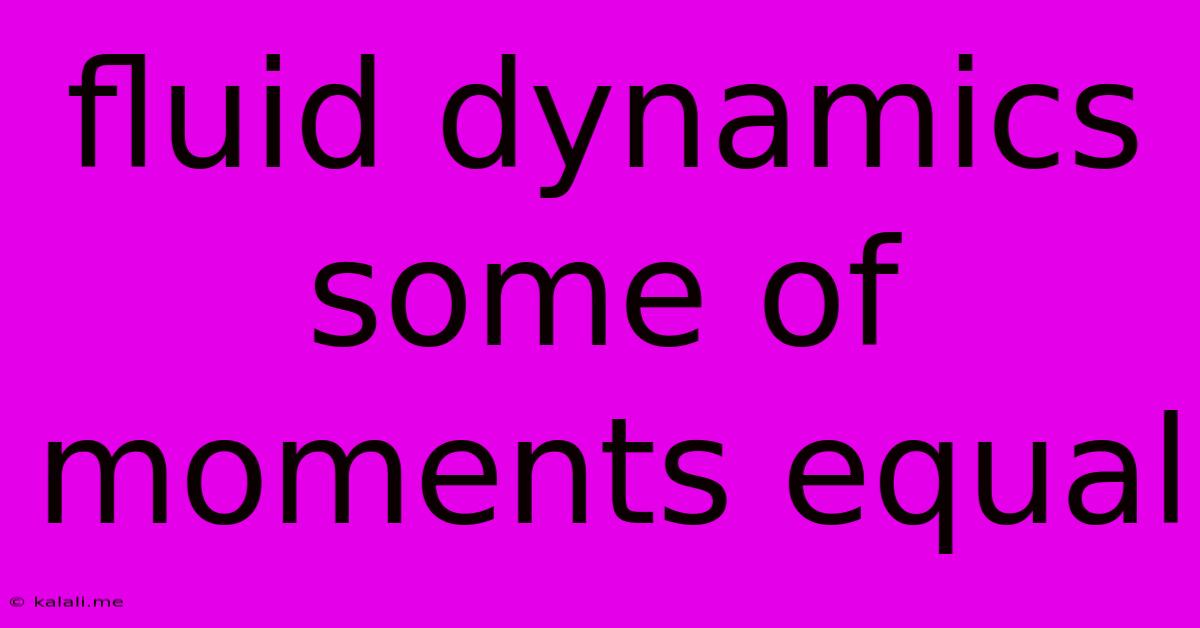Fluid Dynamics Some Of Moments Equal
Kalali
May 25, 2025 · 3 min read

Table of Contents
Understanding Moments of Equal in Fluid Dynamics
Fluid dynamics, the study of fluids in motion, is a complex field with many facets. One crucial concept within this field is the understanding of moments, particularly when dealing with situations where moments are equal. This article will explore the significance of moments in fluid dynamics and delve into scenarios where equality of moments plays a critical role. This will cover the basic principles, relevant equations, and practical applications.
What are Moments in Fluid Dynamics?
In fluid dynamics, a moment refers to the turning effect of a force around a specific point or axis. It's calculated as the product of the force and the perpendicular distance from the point of application of the force to the axis of rotation. Understanding moments is vital for analyzing the stability and equilibrium of fluid systems, particularly in situations involving pressure forces, shear stresses, and buoyant forces. The concept is closely related to torque in mechanics, but applies specifically to fluid forces and pressures.
Moments of Equal: A Critical Balance
The concept of "moments of equal" arises when the sum of the moments acting on a fluid element or system is zero. This signifies a state of rotational equilibrium – the system is not experiencing any net rotational acceleration. This is crucial for various aspects of fluid behavior:
1. Stability of Floating Bodies
Consider a ship floating on water. The buoyant force acts upwards, while the weight acts downwards. For the ship to maintain equilibrium and remain stable, the moments generated by these forces about a chosen pivot point (often the center of gravity or buoyancy) must be equal and opposite. If these moments are unequal, the ship will experience a tilting moment, potentially leading to capsizing. This equilibrium is dynamic; it changes as the ship’s load distribution shifts.
2. Hydrostatic Pressure and Force Distribution
In a static fluid, hydrostatic pressure acts uniformly in all directions. However, when considering a submerged object or a fluid within a container, the pressure distribution can lead to different moments acting on different parts of the object or container walls. Understanding the resultant moment and achieving equal moments is vital in designing structures capable of withstanding the fluid forces.
3. Flow Separation and Vortex Shedding
When a fluid flows past an object, the flow can separate from the surface, leading to the formation of vortices. These vortices generate moments that can significantly affect the object's stability and motion. The phenomenon is observed across various scales, from small-scale vortex shedding behind a cylinder to large-scale vortex formation behind an airplane wing. Accurate prediction of these moments is important for designing aerodynamically sound structures.
4. Rotating Fluid Systems
In systems involving rotating fluids, such as turbines or centrifugal pumps, the moments generated by the fluid's momentum and pressure play a crucial role in their operation. The efficiency and stability of these systems often depend on carefully balancing these moments. Understanding the distribution of angular momentum within the fluid is crucial in predicting the behaviour and performance of these devices.
Practical Applications and Further Exploration
The principle of equal moments is essential across various engineering applications:
- Naval Architecture: Designing stable and seaworthy ships and submarines.
- Aerospace Engineering: Designing aircraft and spacecraft wings to withstand aerodynamic forces.
- Civil Engineering: Designing dams, bridges, and other hydraulic structures to withstand the pressure and forces of water.
- Mechanical Engineering: Designing efficient turbines, pumps, and other rotating machinery.
This article has provided a foundational understanding of moments of equal in fluid dynamics. Further investigation into specific applications and advanced concepts within fluid mechanics is encouraged for a more comprehensive grasp of this vital topic. More advanced studies might involve using computational fluid dynamics (CFD) simulations to analyze complex scenarios where analytical solutions are difficult to obtain. Understanding the interplay of forces, pressure distribution, and rotational equilibrium is vital for success in numerous engineering disciplines.
Latest Posts
Latest Posts
-
Wear Your Heart On Your Sleeve Meaning
May 25, 2025
-
Jabba The Hutt And Princess Leia
May 25, 2025
-
How Tall Was The Tower Of Babel
May 25, 2025
-
You Will Have To Wate After Monday
May 25, 2025
-
How To Prevent Birds From Flying Into Windows
May 25, 2025
Related Post
Thank you for visiting our website which covers about Fluid Dynamics Some Of Moments Equal . We hope the information provided has been useful to you. Feel free to contact us if you have any questions or need further assistance. See you next time and don't miss to bookmark.